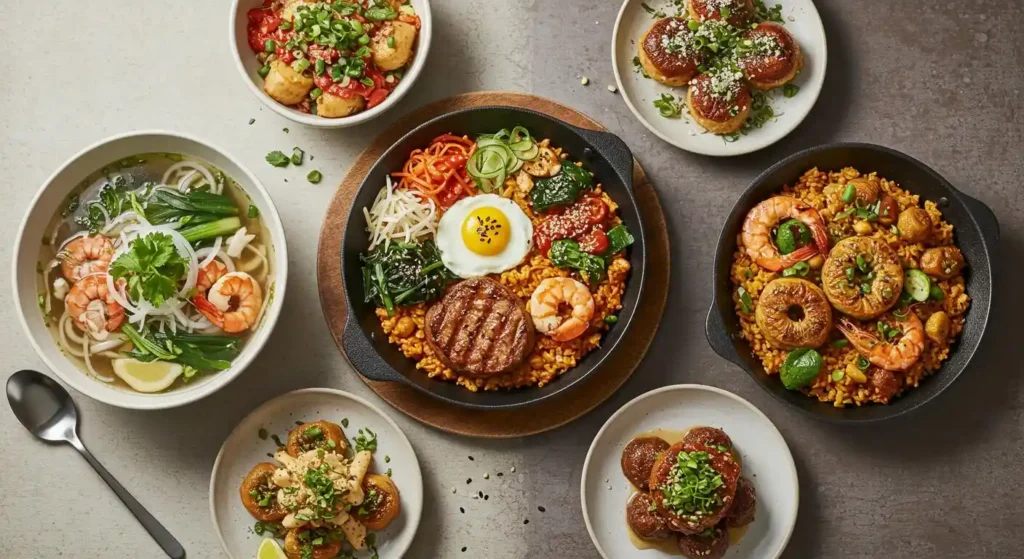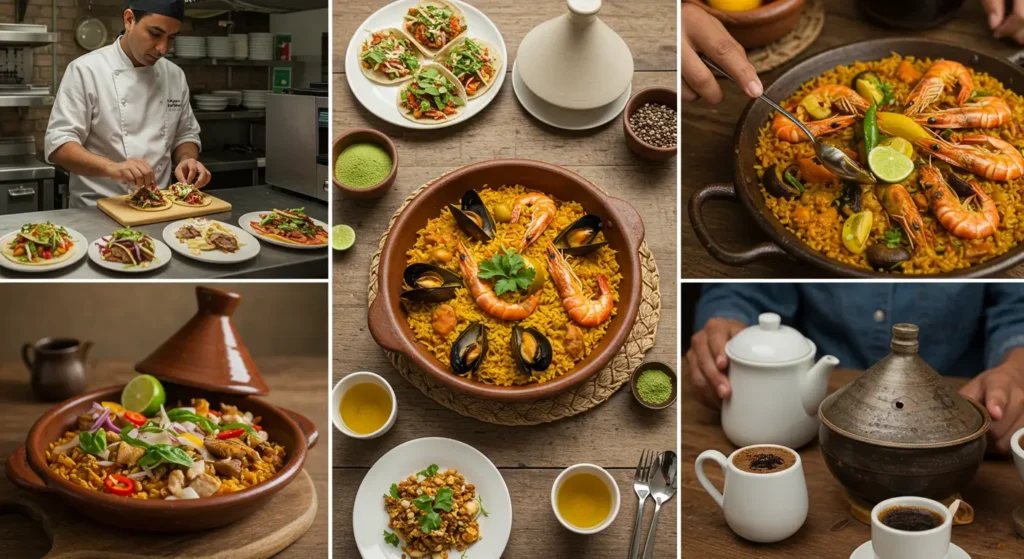Introduction
I still remember the first time I stepped into a bustling Moroccan market. The scent of saffron and cinnamon filled the air as vendors grilled skewers of lamb over open flames. A woman handed me a piece of warm, freshly baked bread, and I dipped it into a rich, spiced tagine. That bite told a story—one of tradition, family, and generations passing down recipes.
As a chef, I’ve spent years exploring kitchens around the world, learning how food shapes culture. Whether it’s a Japanese sushi master perfecting his knife skills or an Italian grandmother rolling out fresh pasta by hand, every dish carries history and meaning.
Join me as we journey through the world’s most fascinating culinary traditions. We’ll explore the flavors, techniques, and stories behind the dishes that bring people together.
Asia: Bold Flavors and Famous Dishes
Asia is a vast continent with a rich variety of flavors, ingredients, and cooking techniques. Each country has its own unique culinary identity, shaped by history and culture. From fiery stir-fries to delicate sushi, Asian cuisine balances flavors with artistic presentation.
China: A Harmony of Flavors and Textures
Chinese cuisine masterfully blends sweet, sour, salty, bitter, and umami flavors. Sichuan dishes like mapo tofu and hot pot bring intense spice, while Cantonese dim sum offers delicate dumplings and buns. Peking duck, with its crispy skin and tender meat, is a famous Beijing specialty. From sizzling stir-fries to hand-pulled dumplings, Chinese food is an adventure in taste and texture.
Japan: The Art of Simplicity and Perfection
Japanese cuisine values precision and natural flavors. Sushi, made with vinegared rice and fresh fish, is a perfect balance of simplicity and umami. Ramen, available in rich tonkotsu and savory shoyu varieties, is a comforting favorite. Teppanyaki turns cooking into a performance, with chefs grilling meats and seafood right before your eyes.
India: A Symphony of Spices and Bold Flavors
Indian cuisine is known for its fragrant spices, slow-cooked curries, and diverse regional dishes. Butter chicken and Goan fish curry highlight the country’s flavorful sauces, best enjoyed with warm, fluffy naan or roti. Biryani, a fragrant rice dish layered with spices and meat or vegetables, is a staple across India. The blend of cumin, coriander, and turmeric gives Indian food its signature depth and warmth.
Thailand: A Perfect Blend of Sweet, Sour, Spicy, and Salty
Thai cuisine thrives on bold, balanced flavors and fresh ingredients. Pad Thai, a stir-fried noodle dish with tamarind, peanuts, and lime, is a global favorite. Green curry, made with coconut milk, basil, and chilies, delivers rich, aromatic spice. The tangy heat of Tom Yum soup, packed with shrimp, lime, and lemongrass, highlights Thailand’s love for intense, fresh flavors.e.
Europe: Classic and Comforting
European cuisine is rich in history and tradition, offering a variety of flavors, ingredients, and cooking techniques. From delicate pastries to hearty stews, every country has its own specialties that make its food unique. While dishes like pasta, bread, and cheese are enjoyed across the continent, each region puts its own spin on them.
France: Buttery Croissants, Rich Sauces, and Elegant Fine Dining
French cuisine is famous for its flaky croissants, creamy cheeses, and indulgent desserts like crème brûlée. The country is also known for its five “mother sauces,” which serve as the foundation for many classic dishes. Whether it’s a rustic boeuf bourguignon or a refined duck confit, French food is all about flavor, technique, and presentation.
Italy: Fresh Pasta, Cheesy Pizza, and Delicious Gelato
Italian food is simple yet packed with flavor, using fresh ingredients like tomatoes, basil, olive oil, and cheese. Handmade pasta comes in countless shapes, from long strands of spaghetti to stuffed ravioli. Italy is also home to the world’s most famous pizza, Neapolitan pizza, known for its thin, crispy crust and fresh toppings. And no meal is complete without a scoop of gelato, Italy’s smooth and creamy version of ice cream.
Spain: Small Shared Plates Called Tapas, Plus Paella and Churros
Spanish cuisine is all about sharing, with tapas—small, flavorful dishes like patatas bravas (crispy potatoes with spicy sauce) and gambas al ajillo (garlic shrimp). The country’s signature dish, paella, is a fragrant saffron-infused rice dish loaded with seafood, chicken, or vegetables. For dessert, churros, crispy fried dough dipped in thick hot chocolate, are a sweet favorite.
Germany: Warm Pretzels, Sausages, and Hearty Stews
German food is hearty and filling, with comforting dishes like bratwurst (grilled sausages) and schnitzel (breaded and fried meat cutlets). Soft, golden pretzels are a popular snack, often enjoyed with mustard or cheese. During colder months, warm stews like Eintopf, made with vegetables, beans, and meat, provide a satisfying and nourishing meal.
European cuisine is diverse yet connected by a love of quality ingredients, traditional cooking methods, and bold flavors. While some foods, like pasta, bread, and cheese, are found across many countries, each culture adds its own special touch. Whether it’s the delicate layers of a French croissant, the smoky flavors of Spanish chorizo, or the comforting richness of an Italian lasagna, European food continues to delight people around the world.
plate, making food a social experience.
Latin America: Colorful and Flavorful
Latin American food blends indigenous, African, and Spanish influences:
- Mexico: Spicy tacos, cheesy quesadillas, and rich mole sauce.
- Peru: Fresh ceviche, made with lime-marinated fish.
- Brazil: Hearty black bean stew called feijoada and juicy grilled meats.
- Caribbean: Spicy jerk chicken, rice and beans, and tropical fruits.
Latin food is full of spices, fresh ingredients, and bold flavors.

Middle East: Ancient Flavors and Hospitality
Middle Eastern cuisine is a blend of rich history, bold spices, and fresh ingredients, creating dishes that are both flavorful and comforting. Meals often include warm bread, aromatic rice, slow-cooked meats, and a variety of dips and spreads. Hospitality is at the heart of the culture, where guests are always welcomed with food and drink.
Lebanon: Mezze, Hummus, and Falafel
Lebanese cuisine is famous for mezze, a selection of small dishes meant for sharing. Popular choices include hummus, a creamy chickpea dip, and falafel, crispy fried balls made from ground chickpeas or fava beans. Fresh herbs, garlic, lemon, and olive oil are key ingredients that give Lebanese food its signature bright and tangy flavors.
Turkey: Kebabs, Börek, and Baklava
Turkish cuisine is known for its savory kebabs, made from marinated meats grilled to perfection. Börek, a flaky pastry filled with cheese, meat, or spinach, is a popular snack or breakfast item. For dessert, baklava, made with layers of phyllo dough, nuts, and honey syrup, is a beloved sweet treat enjoyed across the region.
Iran: Fragrant Rice and Rich Stews
Iranian food is all about aromatic rice dishes and slow-cooked stews packed with deep flavors. Fesenjan, a unique Persian stew made with pomegranate and walnuts, offers a perfect balance of sweet and savory. Rice dishes like chelow kebab, served with saffron-infused rice and grilled meats, showcase the elegance of Persian cuisine.
Arabian Peninsula: Spiced Coffee and Date-Filled Desserts
In the Arabian Peninsula, qahwa (Arabic coffee) is a symbol of hospitality, often served with dates as a sign of welcome. Sweets like maamoul, buttery cookies filled with dates or nuts, are common during special occasions. Spices such as cardamom, cinnamon, and saffron give Arabian desserts their distinct warmth and fragrance.
Sharing food is a cherished tradition in the Middle East, bringing families and friends together around generous, flavorful meals. Whether it’s a plate of freshly baked bread, a bowl of spiced rice, or a tray of sweets, hospitality is at the heart of every dining experience.
Cool Cooking Techniques from Around the World
Different cultures have developed unique cooking methods based on available ingredients, climate, and tradition. Some techniques enhance flavors through slow cooking, while others preserve food for long periods. These time-honored methods continue to be used today, adding depth and character to traditional dishes.
Fermentation – Korean Kimchi and German Sauerkraut
Fermentation is one of the oldest food preservation techniques, using beneficial bacteria to develop complex flavors. In Korea, kimchi—spicy, fermented cabbage—is a staple side dish packed with probiotics and bold seasoning. In Germany, sauerkraut, made from fermented cabbage, adds a tangy crunch to sausages and hearty meals.
Smoking – Texas BBQ and Nordic Smoked Salmon
Smoking food infuses it with a deep, smoky aroma by exposing it to slow-burning wood. In Texas BBQ, meats like brisket are smoked for hours over mesquite or hickory wood for a tender, flavorful result. In Scandinavia, smoked salmon is a delicacy, prepared using a cold-smoking method that preserves the fish’s delicate texture.
Underground Cooking – Hawaiian Imu Pits and Mexican Barbacoa
Cooking food underground allows it to develop rich, tender flavors while sealing in moisture. In Hawaii, the imu pit is used to cook kalua pork, where the meat is wrapped in banana leaves and slow-roasted underground. In Mexico, barbacoa, traditionally made with lamb or goat, is marinated and slow-cooked in underground pits for hours, creating juicy, fall-apart meat.
Stone Cooking – Japanese Ishiyaki (Hot Stone Grilling)
Cooking on heated stones is a simple yet effective method used in many cultures. In Japan, ishiyaki involves grilling thin slices of beef or seafood on sizzling hot lava stones, creating a perfect sear. The technique locks in the meat’s natural juices while adding a slightly smoky flavor.
Clay Pot Cooking – Moroccan Tagine and Indian Biryani
Clay pot cooking is a slow-cooking method that enhances the richness of dishes by sealing in moisture and flavors. In Morocco, tagine—a slow-cooked stew of meat, vegetables, and spices—is prepared in a distinctive cone-shaped clay pot. In India, biryani, a fragrant rice dish, is traditionally cooked in a handi (clay pot), allowing the flavors to blend beautifully.
Each of these cooking techniques has stood the test of time, bringing out the best in ingredients while preserving the rich traditions of different cultures. Whether it’s the smokiness of BBQ, the tang of fermented foods, or the deep flavors of slow-cooked stews, these methods continue to shape how people enjoy food worldwide.
Fun Food Questions & Answers
1. What is the oldest known cuisine?
Mesopotamian cuisine (from modern-day Iraq) is one of the oldest, with recipes dating back over 4,000 years. Chinese, Indian, and Egyptian cuisines also have ancient roots.
2. Why do some cultures eat with their hands?
In Ethiopia and India, people eat with their hands because it connects them to their food and culture. Many Middle Eastern meals are shared from a big platter to show hospitality.
3. What are some must-try traditional dishes?
- Sushi (Japan) – Fresh fish with rice.
- Paella (Spain) – Saffron rice with seafood.
- Jollof Rice (West Africa) – Spicy, tomato-based rice.
- Empanadas (Argentina) – Stuffed pastry pockets.
- Tagine (Morocco) – Slow-cooked stew.
4. What’s the most unique cooking method?
Underground cooking! Hawaiians roast pigs in imu pits, while Mexicans slow-cook meat in barbacoa ovens under the ground.
5. How can I try cooking food from different cultures?
- Follow a recipe from another country.
- Visit an international restaurant or food market.
- Experiment with new ingredients like curry, miso, or plantains.
Conclusion: A World of Flavors
Food is more than just fuel—it connects us to our families, cultures, and history. Whether you’re eating pasta in Italy, sushi in Japan, or tacos in Mexico, every dish has a story.
What’s a food from another country you’d love to try? Have you ever cooked a dish from a different culture? Share your thoughts in the comments!

